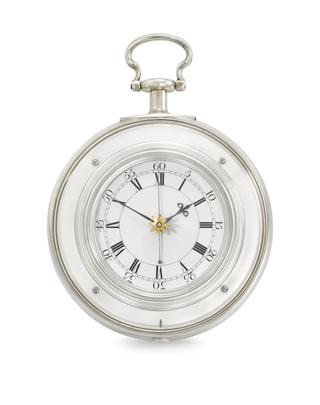
Marine Timekeeper known as 'H5' by John Harrison and Son 1770
1770
Silver pair-cased marine timekeeper, known as H5, by John Harrison & Son, London. White enamel dial with gold central star to adjust hands. Verge escapement with Harrison’s special diamond pallets. Steel balance and spring. Fusee. Maintaining power. 7 1/2 seconds remontoir on 4th wheel. All wheels from the 3rd, jewelled. Long bimetallic strip on adjustable frame. Original key and starting pin. Signed ‘John Harrison & Son London 1770 No. 2’. Case hallmarked for 1768 – 9 and stamped ‘HT’ (probably Henry Taylor who became a free Clockmaker in 1746). With original mahogany carrying case and three silk cushions.
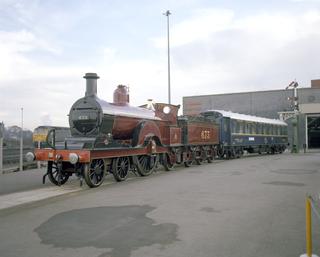
Compagnie Internationale de Wagon-Lits et de Grands Express Europeens sleeping car, 1936
1936
Railway carriage, sleeping car No 3792, Compagnie Internationale de Wagon-Lits et de Grands Express Europeens, built in 1936, withdrawn 31st December 1974. Length over buffers: 65' 6"; width 9' 1"; height 12' 7".

Steam locomotive, entitled Evening Star
1960
Steam locomotive and tender, British Railways, 9F class 2-10-0 No 92220 "Evening Star", designed by R.A.Riddles, built at Swindon in 1960, withdrawn in 1965.

Pullman Car Company, called Topaz
1913
Pullman Car Company First Class Parlour Car "Topaz".

Gold lever escapement watch by John Leroux
1785
Gold pair cased, lever escapement watch by John Leroux, London, 1785. Gold cases stamped VW (for casemaker Valentine Walker) and hallmarked for 1785 – 1786. White enamel dial signed 'Leroux London'. Central minute hand with subsidiary dials for hours and seconds. Gold hands. Movement with lever escapement, for which all the impulse is given by the inclines on the hook-shaped teeth of the steel escape-wheel to pointed pallets on the lever. The short lever is placed tangentially to the escape-wheel. The pallets embrace only two teeth of the escape-wheel. A jewel set in the tail of the lever moves between the adjustable banking pins. The balance staff has a cranked roller for impulse and unlocking, and a separate roller for the safety-dart. The design of this escapement provides draw. The balance is a four-arm steel wheel with timing screws and with two bi-metallic arms fixed to it, with stops to limit their outward movement. The free-sprung balance-spring is conical in shape. Full plate movement with fusee and stop lever. Movement signed 'J. Leroux Charg. Cross London'.
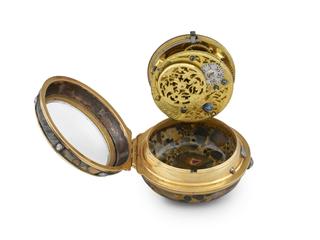
Watch in a puddingstone, gold and diamond case by John Leroux
1775-1785
Verge escapement watch with a puddingstone and gold consular case, inset with rose diamonds, by John Leroux. White enamel dial with gold hands and dial winding. Movement signed ‘Jno. Leroux, London 351’. Late 18th century.
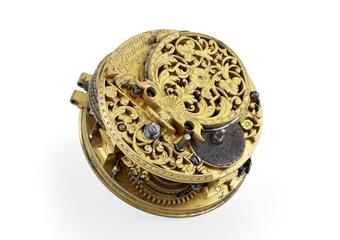
Verge escapement watch movement by Thomas Tompion and George Graham
1711
Verge escapement watch movement by Thomas Tompion and George Graham c.1711 The movement has a white enamel dial and steel beetle and poker hands. It is signed on the backplate ‘Tho Tompion, Geo. Graham London 4369’

'Coronation Class' paint panel, London Midland & Scottish Railway
Paint panel, London Midland & Scottish Railway, blue and silver chevron, pattern for front of 'Coronation Class' streamlined locos. Labelled '5 Streamlined Loco's 6220-6224'. Dimensions: 54 1/4"x36 1/4".
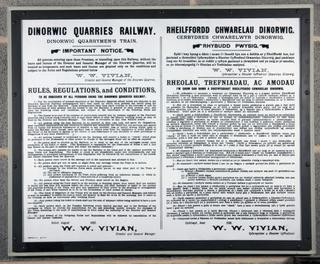
Enamel notice, Dinorwic Quarries Railway
1895
Notice, enamel, Dinorwic Quarries Railway, Rules Regulations & Conditions, 1895, in English and Welsh.
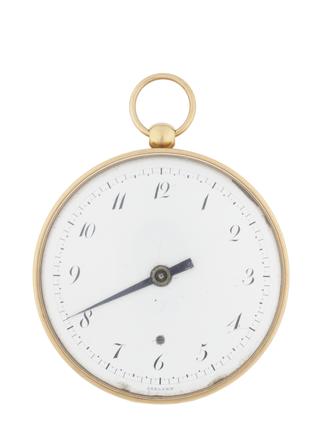
'Souscription' watch by Abraham-Louis Breguet
1800
Gold ‘souscription’ watch by Abraham-Louis Breguet, Paris, c. 1800. Gold case. White enamel dial with secret signature below '12' and signed 'Breguet' around the edge. Single hour hand. Movement with cylinder escapement; the ruby cylinder of Breguet's special type. Brass balance with compensation curb. Movement signed ‘Breguet No. 518’. Clockmakers' Museum No. 368.
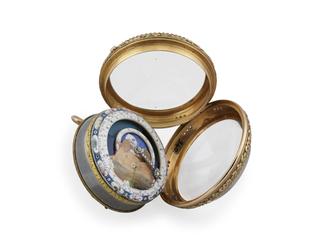
Repeating clock-watch with dials on front and back by Gautrin, Paris
1780
Cylinder escapement watch with dials on both sides, in a three-coloured gold case, by Gautrin, Paris, France, c.1780. The first dial is of white enamel with Arabic numerals indicating hours, days of the week and days of the month. Gold hour and minute hands , blued steel hands for day-of-the-week and day-of-the-month. Three winding apertures. The second dial is painted (by the dial painter Coteau) and shows the symbols of the Zodiac around the outer edge, an annual calendar ring inside this, a semi-circular aperture for shutters to indicate sunrise and sunset, with age and phase of moon in the centre. With single diamond-studded hand. Also with painted pastoral sunset scene. Signed on back 'Coteau 1780'. Movement with steelcylinder escapement and brass escape-wheel. Plain brass balance. There are two mainsprings, both signed 'Vincent Juin 1811'. The back plate is signed 'Gautrin à Paris N° 481' and a band round the movement is signed 'Gautrin invenitque fecit'. Repeating clock-watch. The watch has a short chain and two keys

'Early 'perpetuelle' watch by Abraham-Louis Breguet
1783-1800
Quarter-repeating, self-winding watch with gold engine-turned case, by Abraham-Louis Breguet c.1783. On the back of the case is a crowned ‘N’. The white enamel dial has Breguet's secret signature. Both dial and case are most likely later replacements by Breguet. Blued steel 'Breguet' hands. Cylinder escapement, with no compensation on the balance. Quarter repeating and self-winding. Signed ‘Breguet à Paris 810/83’.
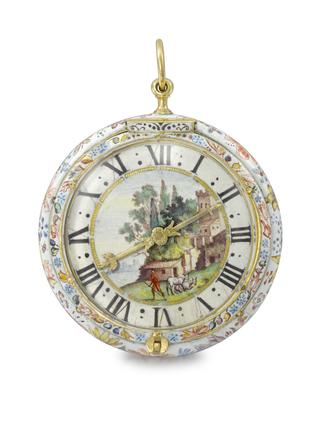
Watch by David Margotin with a Blois Enamelled Case
1601-1700
Watch in fine enamelled case by David Margotin, Paris, France . The exterior of the case is painted with an array of coloured spring flowers, the interior with a château beside a lake. The enamel dial is painted with a rural scene, The movement has a screwed on balance cock and ratchet wheel set-up and is signed ‘David Margotin, Paris’. c.1650.

Repeating watch by William Andreas Enderlin with enamel in the manner of Jean Mussard V
1700-1725
Repeating watch by William Andreas Enderlin, Basel, Switzerland, early 18th Century. Silver case, with repoussé scene of of Venus and cupids on the back, edges pierced and engraved, and bezel engraved. Gilt dial with enamel plaques for hours and minutes. Steel hands. Movement with repeating work, verge escapement and bridge-type balance cock with an enamel depicting Pero and Cimon (Roman Charity), in the manner of Jean (V) Mussard (1681-1754). Signed on the backplate 'An. Enderlin A Bale'. Clockmakers' Museum No. 80

Gold watch with tourbillon by Girard Perregaux
1879
Gold watch with tourbillon by Girard Perregaux, Switzerland, 1879. Gold hunter case engraved all over with flowers and foliage, and with English hallmark dated 1879 and stamped 51701 and 14961. Signed on the cuvette 'Cronometro, Tourbillon, Girard Perregaux, Chaux de Fonds'. White enamel dial with subsidiary seconds and signed 'Girard Perregaux, Chaux de Fonds'. Gold hands. Jewelled movement with pivoted detent escapement and tourbillon, and signed on the central bridge 'Girard Perregaux, Chaux de Fonds'. Originally part of the collection of the Reverand Henry Nelthropp and later donated to the museum of the Worshipful Company of Clockmakers. Clockmakers' Museum Number 452

Gold and enamel watch by Robert Robin
1785-1795
Thin watch in a gold and enamel case by Robin, Paris, France, late 18th century. Gold case, the back enamelled with a scene depicting a warrior holding an arrow to a yielding female, both to the left of a garlanded and flaming obelisk. The bezels are set with two rows of split pearls, separated on the back by a ring of alternate blue and white enamel elements. The pendant and bow also with blue, white and gold enamel decoration. White enamel dial with winding hole at 2 and with hands set with brilliants. Dial signed 'Robin A Paris'. Movement with verge escapement, signed ‘Robin A Paris’. Clockmakers' Museum No. 1144.

Silver vinaigrette in the shape of a harp, France, 1701-1800
1701-1800
Silver gilt vinaigrette in the form of a harp, stem and sides enamelled with blue and floral and pastoral decoration, with perforated inner cover, probably French, probably 18th century

Oval enamelled box, England, 1761-1820
1761-1820
Oval enamelled box, with hinged lid and mirror inside lid, possibly for patches, a souvenir from Bath, English, 1761-1820

Chronometer in Gold Case by Thomas Earnsham, 1795-1810
1795-1810
Gold-cased Chronometer watch no.728 made by Thomas Earnshaw, 1795-1810

Desk telephone transmitter and receiver (sectioned), 1926.
1926
Sectioned desk telephone transmitter and receiver, made by the Automatic Telephone Manufacturing Company, Edge Hill, Liverpool, England, 1926

Enamelled notice regarding stone throwing, 1910-1936
1910-1936
Enamelled notice "Persons throwing stones at the telegraph will be prosecuted", unknown maker for the General Post Office, British, 1910-1936
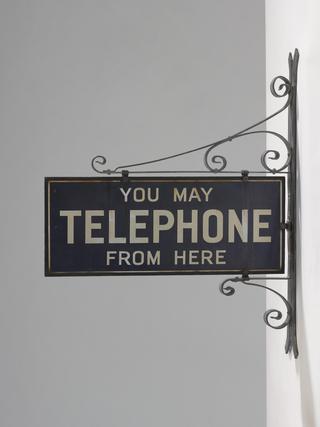
'You may telephone from here' sign, 1910-1936
1910-1936
Enamelled sign with bracket: "You may telephone from here", unknown maker for the General Post Office, British, 1910-1936

Deck-watch used by Capt. George Vancouver on board HMS Discovery 1791-5
1791
Silver pair cased deck-watch by Thomas Earnshaw, London, hallmarked for 1791-2. White enamel dial with a subsidiary seconds dial and signed 'Thomas Earnshaw Invt et Fecit No.58'. Movement with spring detent escapement and two-arm bi-metallic compensation balance with wedge weights. Signed on the movement 'Thos. Earnshaw London Invt. et Fecit. no 1514’

Watch with faceted oval rock crystal case and protective outer case by John Ramsay
1625
Verge escapement watch with faceted oval rock crystal case and protective outer case by John Ramsay, c.1625. The protective outer case is of gilt metal. The watch's main case is made from three pieces of rock crystal; two cut into facets to form the covers, and the third carved to form the body of the case. The crystal pieces are set in a gilt-metal frame enamelled in white and green. The dial is made from cloisonné white enamel with flowers, with a gold chapter ring and a blued steel hand. The movement has a verge escapement, a train of three wheels, a screwed-on balance cock and worm and wheel set-up. The movement is signed 'John Ramsay fecit'.

Pivoted-detent escapement watch by Larcum Kendall
1786
Silver pair cased watch by Larcum Kendall, halmarked 1786-7. White enamel dial with subsidiary dials for hours and seconds. Movement with pivoted detent escapement, brass balance with spiral bi-metallic compensation curb. The passing spring is operated by an inclined plane on the balance staff. Signed on the movement 'L. Kendall London B+y'
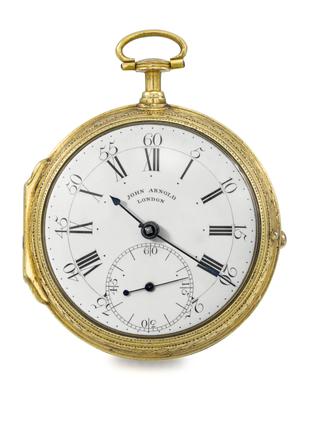
Pivoted-detent escapement watch by John Arnold
1776
Pivoted detent escapement watch by John Arnold in a silver-gilt case with monogram ‘C.M.’ surrounded by chiselled wreaths. White enamel dial with a subsidiary seconds dial and steel hands. Pivoted detent s-shaped balance and helical balance spring. Signed ‘John Arnold Invt. et Fecit No. 28’. London, hallmarked 1776-7
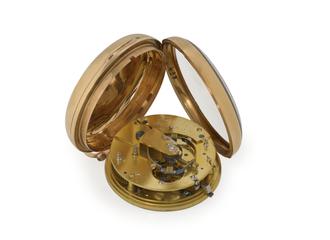
Spring-detent escapement watch in a gold case by Reid & Co. London
1807
Spring detent escapement watch in a gold case by Reid & Co., London with attached chain and winding key with semi-precious stones. Case hallmarked for 1807-8 and stamped with casemaker's mark 'LC'. White enamel dial with a subsidiary seconds dial, and blued steel loop hands. Diamond endstone. Spring detent escapement with helical spring and compensation balance. Signed ‘Reid and Co. London 1808’.

Gold watch with champlevé enamel dial by Edward East
1650
Gold watch with a red and blue champlevé enamel dial by Edward East. The fusee movement has a three wheel train,verge escapement, pinned on balance cock and ratchet wheel set-up. Signed ‘Eduardus East Londini’. c.1650. Presented to the museum of the Worshipful Company of Clockmakers by Gerald Sydney Sanders in 1964.
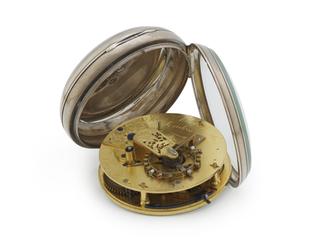
Deck watch by John Arnold and Son
1790
Deck watch by John Arnold & Son, London, c.1790. Outer mahogany deck-box, with Ivory tab signed 'Arnold & Son, London, 112' and broad arrow mark. Later silver case stamped with 112 with maker's initials JJ, and hallmarked for 1838 – 9. Enamel dial signed ‘Arnold & Son, London 112’. Jewelled movement with Earnshaw-type spring detent escapement. Signed on the movement 'John Arnold & Son London No. 112 Invt et Fec' also with broad arrow mark. Presented by the Lords Commissioners of the Admiralty to the Worshipful Company of Clockmakers in 1906. Clockmakers' Museum No. 431.
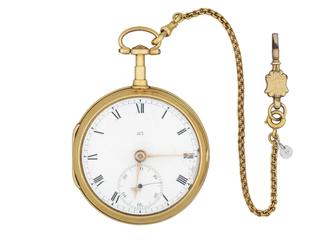
Spring-detent escapement watch with gold case by John Arnold and Son
1796
White enamel dial with subsidiary seconds dial. Gold minute and hour hands with blued steel seconds hand. Spring detent escapement with Z balance and steel helical spring of four turns. Signed ‘John Arnold & Son London Invt. et Fect. 513/814’. Gold case, stamped with casemaker's mark 'TH', and 513.
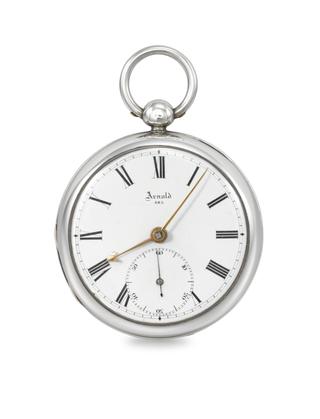
Spring detent watch by John Arnold, used by Ruth Bellville and family to distribute GMT c.1834-1940
1794
Spring detent escapement watch by John Arnold, in a later silver case. White enamel dial with a subsidiary seconds dial and gold spade hands. Jewelled movement with diamond endstone. The original escapement has a later conversion to Earnshaw's spring detent arrangement, and has a later type of two-arm compensation balance. Signed 'John Arnold & Son, London. Invenit & fecit 485/786'. Movement c.1794, case hallmarked for 1840, casemaker's mark 'CBH' and stamped 485.

Spring-detent escapement watch with gold case by John Barwise
1800
Gold spring-detent escapement watch by John Barwise. Gold case stamped VW (for casemaker Valentine Walker) and hallmarked for 1799 – 1800. White enamel dial signed Barwise, London, 158'. Subsidiary dials for hours, minutes and up-and-down indicator, all with gold hands, and a seconds dial with blued steel hand. Spring detent escapement; a lightened version of Earnshaw’s arrangement. Solid 3-armed brass balance with two bi-metallic arms fixed to it. Jewelled pivot holes and diamond endstone. Signed on movement ‘Barwise, London, No. 158’.
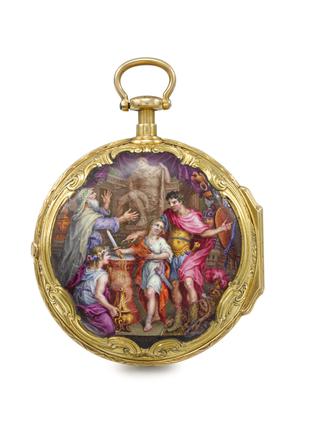
Cylinder watch with enamelled gold case made for Queen Charlotte
1740-1760
'Cylinder escapement 'dumb repeater' watch by Conyers Dunlop, with enamelled gold case signed by George Michael Moser, made for Queen Charlotte (1744-1818). White enamel dial with steel beetle hands and an aperture for winding. Engraved and pierced balance cock with diamond endstone. Signed ‘Conrs Dunlop London 3383’. Mid-18th Century.
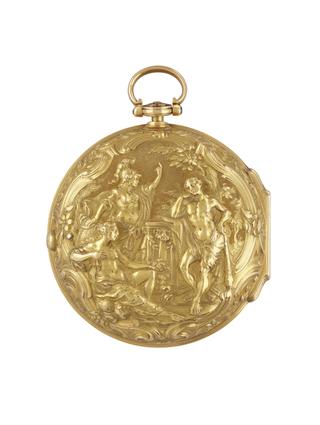
Gold repoussé watch depicting the Choice of Hercules, by John Ellicott
1767
Pair cased gold watch with outer case in high repoussé. Movement by John Ellicott, London, case signed Manly F and hallmarked 1767 – 1768. Outer case in gold repoussé, the inner case in plain gold. White enamel dial with Arabic hour numerals and gold hands. Cylinder escapement with diamond endstone. Backplate signed ‘Ellicott London 6027’. Dust cap, also signed ‘Ellicott London 6027’.

Watch movement by Thomas Tompion with a later case and dial
1680
Watch movement, with later dial and pair case, by Thomas Tompion, London c.1680. The outer case is covered in tortoiseshell inlaid with silver in a pattern of birds and flowers, the inner case is plain silver. The white enamel dial has steel beetle and poker hands. The movement has a verge escapement, four wheels in its train, and an unusal shaped balance cock. The balance-spring has 4 turns and is therefore probably not the original spring. The movement is signed 'Tho Tompion London' but is not numbered and therefore made prior to about 1680.

Under-painted horn pair cased watch by George Flote
1800
Pair cased watch by George Flote, London c.1800. The inner case is made of gilt-metal, the outer covered with horn and under-painted with the arms of the Clockmakers’ Company. White enamel dial with gold coloured hands. Movement with verge escapement, and engraved and pierced balance cock, signed ‘Geoe. Flote London 1790’. Clockmakers' Museum No. 279

Quarter-repeating watch by George Graham
1745
Gold pair cased watch, with quarter-repeating on bell, by George Graham. Gold inner case with pierced and engraved edges, wilth bell screwed to the inside. Outer case covered with leather and studded with gold. White enamel dial with steel beetle hands. Signed dust cap, scratched on the inside with the number 883. Movement with repeating mechanism, cylinder escapement, and pierced and engraved balance cock with diamond endstone. Signed ‘Geo. Graham London 883’, hallmarked for 1745 – 6
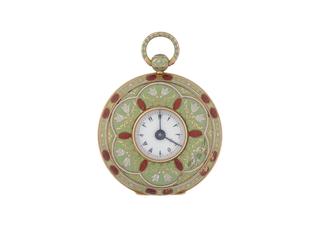
Watch with enamel case made for the Turkish market
1805-1815
Watch with a half-hunter gold case, enamelled red and green, made for the Turkish market. Unknown maker, Switzerland, c.1810. White enamel dial with ‘Turkish’ numerals and blued steel loop hands. Movement with verge escapement and bridge balance cock. Clockmakers' Museum No. 1141

Gold watch by Recordon
1807
Watch by Recordon, London, hallmarked 1807 – 8. Gold engine turned case with flat engine turned edge-band, case stamped with the makers mark 'FC'. White enamel dial with subsidiary seconds and moon shaped hands. Signed ‘Recordon, late Emery, London’ on dial. Movement with compensation balance and later lever escapement and jewelling. Movement signed ‘Recordon, late Emery. Cockspur Street, Charing Cross, London No. 7392’. Clockmakers' Museum No. 463
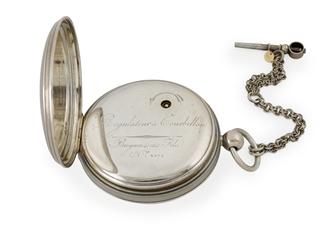
Silver one-minute tourbillon watch by Abraham-Louis Breguet, sold to the Princess de Valençay in 1812.
1812
Lever escapement watch by Abraham-Louis Breguet, 1812. Silver case, the back engine turned with an engraved crown covered with clear grey enamel in the centre. Silver chain and key attached. The cuvette is signed ‘Breguet et Fils. Regulateur à Tourbillon no. 2571’. White enamel dial with arabic hour figures and a subsidiary seconds dial. Blued steel 'Breguet' hands. Dial signed ‘Breguet’ in cursive script, with a secret signature underneath. One minute tourbillon with Breguet’s first form of lever escapement. Unsigned full plate fusee movement, with balance and tourbillon carriage outside of plates. Two arm balance with 2 bimetallic compensation strips attached to each arm. Freesprung spiral balance spring with overcoil.

Lever escapement watch by Josiah Emery
1792
Gold straight line lever escapement watch by Josiah Emery, London. Gold case, stamped VW (for casemaker Valentine Walker) and hallmarked 1792 – 3. White enamel dial with blued steel central minute hand and subsidiary dials for hours and seconds. Signed Emery London. Full-plate gilt movement with balance bridge. Straight line lever escapement, without draw. The balance staff has a cranked roller for impulse and unlocking and there is a separate safety roller. Brass balance with timing screws and two S-shaped bi-metallic arms. Helical balance spring. The pallets of the lever embrace five teeth of the escape-wheel. Signed ‘Josiah Emery, Charing Cross, London 1289’. Dust cap, also signed 'Josiah Emery Charing Cross London 1289'.

Watch movement with remontoir and two balance springs by Thomas Mudge
1755
Watch movement numbered 260, by Thomas Mudge, London, 1755. White enamel dial with large minute figures and steel beetle hands and a centre seconds hand, placed between the hour and minute hands. The fusee movement contains a verge escapement, a remontoir, and balance with two balance springs; one with curb compensation and the other with regulator. The minute hand jumps forward once every minute. The fusee has no maintaining power, but a pivoted detent prevents the remontoir wheel from running back during winding. A stop acts on the wheel carrying the seconds hand, allowing it to be halted. When the stop is taken off a small hook engages with the wheel teeth, thus ensuring an immediate advance of the seconds hand. Signed on the movement 'Thos Mudge London 260'. Originally sold to Ferdinand, King of Spain on August 22nd 1755. Presented to the Worshipful Company of Clockmakers by John Grant Jnr in 1850. Clockmakers' Museum No. 189
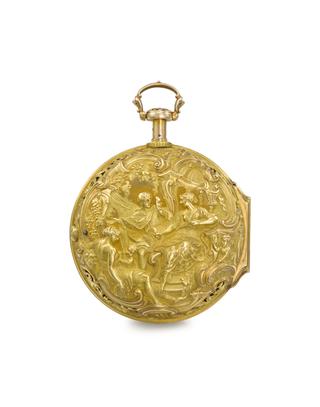
Triple-cased quarter-repeater watch by Paul du Pin
1739
Triple cased, verge escapement, quarter-repeater watch by Paul Du Pin. The middle and inner cases are of gold, and the outer covered in leather. The middle case is formed in high relief repoussée and signed ‘Moser’, the inner case is pierced and engraved. White enamel dial with gold beetle hands. Repeats on bell in the bezel of the middle case. Dust cap. Signed ‘Paul du Pin London 1530’. Hallmarked 1739 – 40

English lever escapement watch with Karrusel by S Smith and Son
1897
English lever escapement watch with karrusel carriage in a silver case with gold hinges by S. Smith & Son, London. Case stamped ‘J.W.’and hallmarked 1897. White enamel dial inscribed 20794, with steel hands. The karrusel revolves in fifty two and a half minutes. Free sprung. Single-roller lever escapement. The back plate is engraved ‘Kew Class A Certificate 70.4 marks. 20794. Watchmakers to the Admiralty. S. Smith & Son. 9 Strand, London’.

Verge watch in Staffordshire enamelled case by Ann Phillips
1790
Verge escapement watch with gilt-metal Staffordshire enamelled case by Ann Phillips White enamel dial with gold hands, and winding achieved through an aperture in the dial. Engraved and pierced balance cock, signed ‘Ann Phillips, London 1778’. c.1790

A Royal watch by Samuel Houston
1807
Silver watch by Samuel Houston, Dublin, c.1805. Silver consular case with wide plain band, hallmark for 1807 and casemaker's mark 'CC'. On the rear of the case is engraved a Royal Crown and the inscription ‘C.P. This watch was worn by H.R.H. the Princess Charlotte until she was twelve Yrs old & then presented by HRH to Henry Kuper.’ White enamel dial with upright Roman chapter-numerals, winding through a IIII. Gold spade and pointed hands Full-plate movement with verge escapement, 5-armed plain steel balance, blued-steel index indicating against scale engraved on plate, early wedge-shaped cock and backplate signed 'Saml. Houston, London. 794'. Clockmakers' Museum No. 793

Watch by Vulliamy, London
Watch by Vulliamy, London. Movement early 19th century, with later case hallmarked for 1869 and stamped with the makers mark 'JS' and 350. White enamel dial with steel hands. Movement with dust cap, duplex escapement and compensation curb. Signed ‘Vulliamy, London SZAA’. Clockmakers' Museum No. 1183.

Verge escapement watch movement with balance-spring regulator, by John Shaw
1601-1700
Verge escapement watch movement with later enamel dial by John Shaw. One half of the balance-cock table is engraved ‘To Increase the figure will make it goe faster & to Decrease it slower’. The other half of the table is cut away to reveal the balance-spring with a regulating device for adjusting the length of the balance-spring. Beneath this is engraved 'Slower, Faster' and a scale of I-V in an arc. The backplate is signed ‘John Shaw, Holborn, 546’. London c.1690.

Gold repeating watch by William Webster
circa 1715
Gold repeating watch by William Webster, London, c.1715. Later engraved gold case and enamel dial, steel hands. Movement with verge escapement and dumb-repeating, signed Wm Webster, Exchange Ally, London, 439.' Early engraved dust-cap, signed Wm Webster, Exchange Ally, London, 489.' Clockmakers' Museum No. 1204

Chronometer movement by John Arnold & Son
1795
Chronometer movement by John Arnold and Son, London, c.1795. White enamel dial with subsidiary seconds, signed ‘John Arnold & Son London No. 101’. Fusee movement of two day duration with spring detent escapement, Z-balance and gold balance spring. Movement numbered 101/191. Presented in 1875 to the Worshipful Company of Clockmakers by Charles Frodsham & Co., Clockmakers' Museum No. 605.